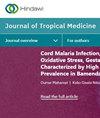In Vitro Antischistosomal Activity of Bridelia ferruginea, Clausena anisata, Khaya senegalensis, and Vernonia amygdalina
IF 2.1
4区 医学
Q3 PUBLIC, ENVIRONMENTAL & OCCUPATIONAL HEALTH
引用次数: 0
Abstract
Background. Schistosomiasis is caused by parasitic flatworms and the disease is endemic to most countries in sub-Saharan Africa including Ghana. The current therapeutic agent for managing this disease solely relies on praziquantel. The continual dependence on this single available drug could lead to possible drug resistance. This study seeks to evaluate the antischistosomal activity of the following Ghanaian medicinal plants: Khaya senegalensis, Vernonia amygdalina, Clausena anisata, and Bridelia ferruginea. Methodology. Two concentrations (100 μg/mL and 50 μg/mL) of each extract were tested in a 96-well plate containing 30 newly transformed schistosomula (NTS). Moreover, six worms of both sexes of adult Schistosoma mansoni were exposed to the extracts diluted in the RPMI medium. The assay was performed in a 24-well plate. The parasitic worms were examined using an inverted optical microscope. Results. At 100 μg/mL and 50 μg/mL, all extracts performed better and showed strong activity () against NTS; thus, 98.08%, 100%, 80.77%, and 100% for Clausena, Vernonia, Bridelia, and Khaya, respectively, when compared to praziquantel. Strong activity was recorded when the extracts underwent testing against Schistosoma mansoni adults at 100 μg/mL; 96.35%, 100%, and 94.55% for Vernonia, Bridelia, and Khaya, respectively, except for Clausena which exhibited weak activity, i.e., 56.02%. There was no significant difference between Vernonia, Bridelia, and Khaya when compared to praziquantel. Conclusion. At 100 μg/mL, Khaya senegalensis, Vernonia amygdalina, and Bridelia ferruginea extracts demonstrated strong activity against both schistosomula and adult Schistosoma mansoni. These data can serve as baseline information in the quest to find alternative therapeutic agents to treat schistosomiasis.Bridelia ferruginea、Clausena anisata、Khaya senegalensis 和 Vernonia amygdalina 的体外抗血吸虫活性
背景。血吸虫病由扁形寄生虫引起,在包括加纳在内的撒哈拉以南非洲大多数国家流行。目前治疗这种疾病的药物主要是吡喹酮。对这种单一药物的持续依赖可能会导致耐药性。本研究旨在评估以下加纳药用植物的抗吸虫活性:Khaya senegalensis、Vernonia amygdalina、Clausena anisata 和 Bridelia ferruginea。研究方法。在含有 30 只新转化血吸虫(NTS)的 96 孔板中测试每种提取物的两种浓度(100 μg/mL 和 50 μg/mL)。此外,曼氏血吸虫成虫的 6 只雌雄虫也暴露于稀释在 RPMI 培养基中的提取物。试验在 24 孔板中进行。使用倒置光学显微镜检查寄生虫。结果在100 μg/mL和50 μg/mL浓度下,所有提取物对NTS都有较好的活性,与吡喹酮相比,Clausena、Vernonia、Bridelia和Khaya的活性分别为98.08%、100%、80.77%和100%。在对曼氏血吸虫成虫进行 100 μg/mL 的测试时,Vernonia、Bridelia 和 Khaya 的提取物具有很强的活性,分别为 96.35%、100% 和 94.55%,只有 Clausena 的活性较弱,仅为 56.02%。与吡喹酮相比,Vernonia、Bridelia 和 Khaya 没有明显差异。结论在 100 μg/mL 的浓度下,Khaya senegalensis、Vernonia amygdalina 和 Bridelia ferruginea 提取物对血吸虫和曼氏血吸虫成虫都有很强的活性。这些数据可作为寻找治疗血吸虫病的替代药物的基础信息。
本文章由计算机程序翻译,如有差异,请以英文原文为准。
求助全文
约1分钟内获得全文
求助全文
来源期刊

Journal of Tropical Medicine
Immunology and Microbiology-Parasitology
CiteScore
3.90
自引率
4.50%
发文量
0
审稿时长
14 weeks
期刊介绍:
Journal of Tropical Medicine is a peer-reviewed, Open Access journal that publishes original research articles, review articles, and clinical studies on all aspects of tropical diseases. Articles on the pathology, diagnosis, and treatment of tropical diseases, parasites and their hosts, epidemiology, and public health issues will be considered. Journal of Tropical Medicine aims to facilitate the communication of advances addressing global health and mortality relating to tropical diseases.
 求助内容:
求助内容: 应助结果提醒方式:
应助结果提醒方式:


